The Orthorhombic Crystal System
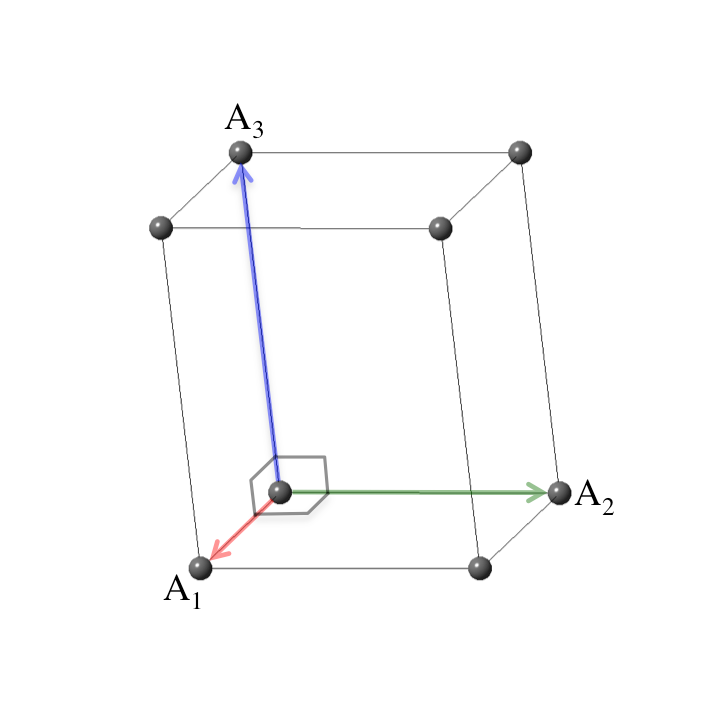
In the orthorhombic system, the conventional unit cell is a
parallelepiped defined by three mutually orthogonal vectors of
unequal length:
\begin{eqnarray}
\mathbf{A}_1 & = & a \, \mathbf{\hat{x}} \nonumber \\
\mathbf{A}_2 & = & b \, \mathbf{\hat{y}} \nonumber \\
\mathbf{A}_3 & = & c \, \mathbf{\hat{z}},
\end{eqnarray}
so that $a \ne b \ne c$, but $\alpha = \beta = \gamma = \pi/2$. It
is a limiting case of the conventional monoclinic crystal with
$\beta \rightarrow \pi/2$.
The volume of the conventional unit cell is
\begin{equation}
V = a \, b \, c .
\end{equation}
There are four Bravais lattices in the
orthorhombic system.
Lattice 4: Simple Orthorhombic
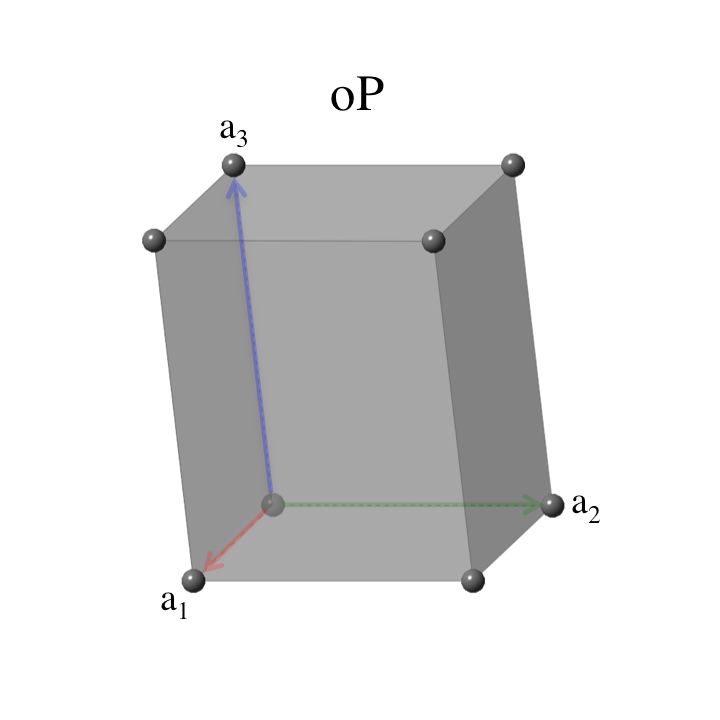
The simple orthorhombic Bravais lattice is identical to the
conventional cell
\begin{eqnarray}
\mathbf{a}_1 & = & a \, \mathbf{\hat{x}} \nonumber \\
\mathbf{a}_2 & = & b \, \mathbf{\hat{y}} \nonumber \\
\mathbf{a}_3 & = & c \, \mathbf{\hat{z}},
\end{eqnarray}
with volume
\begin{equation}
V = a \, b \, c ~.
\end{equation}
The space groups associated with the simple orthorhombic lattice are
\begin{array}{lll}
16. ~ \mbox{P222} & 17. ~ \mbox{P222$_{1}$} & 18. ~ \mbox{P2$_{1}$2$_{1}$2} \\
19. ~ \mbox{P2$_{1}$2$_{1}$2$_{1}$} & 25. ~ \mbox{Pmm2} & 26. ~ \mbox{Pmc2$_{1}$} \\
27. ~ \mbox{Pcc2} & 28. ~ \mbox{Pma2} & 29. ~ \mbox{Pca2$_{1}$} \\
30. ~ \mbox{Pnc2} & 31. ~ \mbox{Pmn2$_{1}$} & 32. ~ \mbox{Pba2} \\
33. ~ \mbox{Pna2$_{1}$} & 34. ~ \mbox{Pnn2} & 47. ~ \mbox{Pmmm} \\
48. ~ \mbox{Pnnn} & 49. ~ \mbox{Pccm} & 50. ~ \mbox{Pban} \\
51. ~ \mbox{Pmma} & 52. ~ \mbox{Pnna} & 53. ~ \mbox{Pmna} \\
54. ~ \mbox{Pcca} & 55. ~ \mbox{Pbam} & 56. ~ \mbox{Pccn} \\
57. ~ \mbox{Pbcm} & 58. ~ \mbox{Pnnm} & 59. ~ \mbox{Pmmn} \\
60. ~ \mbox{Pbcn} & 61. ~ \mbox{Pbca} & 62. ~ \mbox{Pnma} \\
\end{array}
Lattice 5: Base-Centered Orthorhombic
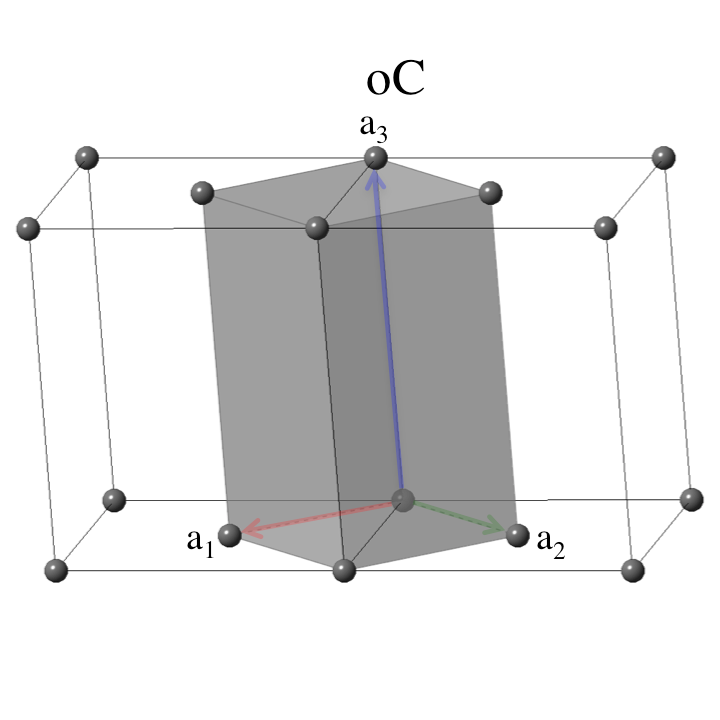
Like the base-centered monoclinic lattice, the base-centered
orthorhombic system allows a translation in one of the base
planes. Unfortunately, the standard plane chosen depends on the
space group, as shown in the table below. Space groups
beginning with C put the translation in the $a-b$ plane, that is, the
plane defined by $\mathbf{A}_1$ and $\mathbf{A}_2$. In
this case the primitive vectors can be taken to be
\begin{eqnarray}
\mathbf{a}_1 & = & \frac{a}{2} \, \mathbf{\hat{x}} - \frac{b}{2} \, \mathbf{\hat{y}}
\nonumber \\
\mathbf{a}_2 & = & \frac{a}{2} \, \mathbf{\hat{x}} + \frac{b}{2} \, \mathbf{\hat{y}}
\nonumber \\
\mathbf{a}_3 & = & c \, \mathbf{\hat{z}} ~.
\end{eqnarray}
Space groups beginning with A put the translation in the $b-c$ plane,
defined by $\mathbf{A}_2$ and $\mathbf{A}_3$. We use the primitive vectors
\begin{eqnarray}
\mathbf{a}_1 & = & a \, \mathbf{\hat{x}} \nonumber \\
\mathbf{a}_2 & = & \frac{b}{2} \, \mathbf{\hat{y}} - \frac{c}{2} \, \mathbf{\hat{z}}
\nonumber \\
\mathbf{a}_3 & = & \frac{b}{2} \, \mathbf{\hat{y}} + \frac{c}{2} \, \mathbf{\hat{z}}.
\end{eqnarray}
The above orientation is not used by
Setyawan and Curtarolo
who only considered centering in the
Cplane defined by $\mathbf{a}_2$ and $\mathbf{a}_3$. A simple rotation brings the vectors into agreement. In both cases the volume of the primitive unit cell is \begin{equation} V = \frac{a \, b \, c}{2}. \end{equation} There are two primitive base-centered orthorhombic unit cells in the conventional orthorhombic unit cell. The space groups associated with the base-centered orthorhombic lattice are \begin{array}{lll} 20. ~ \mbox{C222$_{1}$} & 21. ~ \mbox{C222} & 35. ~ \mbox{Cmm2} \\ 36. ~ \mbox{Cmc2$_{1}$} & 37. ~ \mbox{Ccc2} & 38. ~ \mbox{Amm2} \\ 39. ~ \mbox{Abm2} & 40. ~ \mbox{Ama2} & 41. ~ \mbox{Aba2} \\ 63. ~ \mbox{Cmcm} & 64. ~ \mbox{Cmca} & 65. ~ \mbox{Cmmm} \\ 66. ~ \mbox{Cccm} & 67. ~ \mbox{Cmma} & 68. ~ \mbox{Ccca} \\ \end{array}
Lattice 6: Body-Centered Orthorhombic
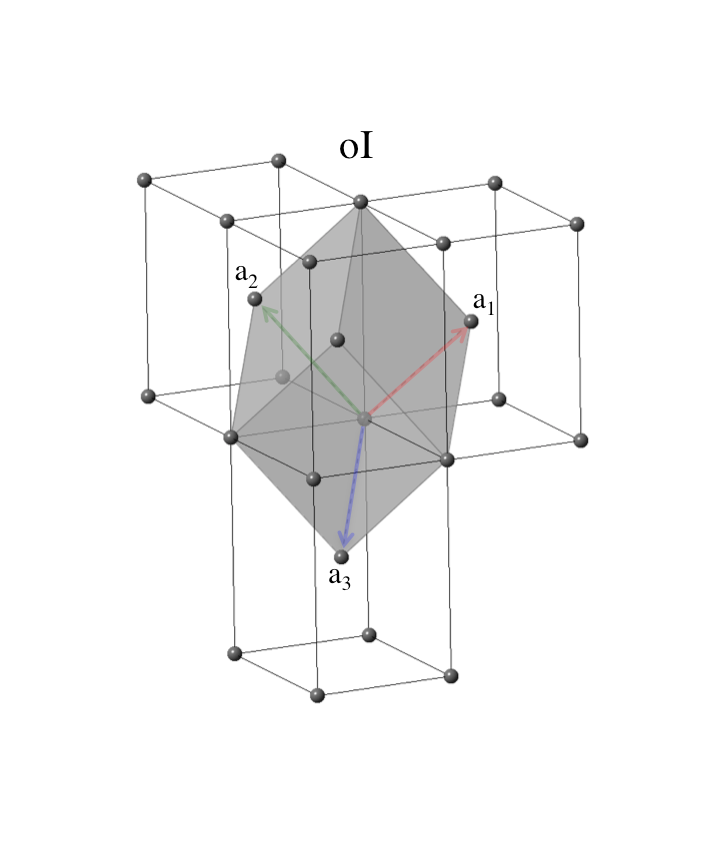
The body-centered orthorhombic lattice has the same point group and
translational symmetry as the simple orthorhombic system, with the
addition of a translation to the center of the parallelepiped.
Our standard form of the primitive vectors is
\begin{eqnarray}
\mathbf{a}_1 & = & - \frac{a}{2} \, \mathbf{\hat{x}} + \frac{b}{2} \, \mathbf{\hat{y}}
+ \frac{c}{2} \, \mathbf{\hat{z}} \nonumber \\
\mathbf{a}_2 & = & ~ \frac{a}{2} \, \mathbf{\hat{x}} - \frac{b}{2} \, \mathbf{\hat{y}}
+ \frac{c}{2} \, \mathbf{\hat{z}} \nonumber \\
\mathbf{a}_3 & = & ~ \frac{a}{2} \, \mathbf{\hat{x}} + \frac{b}{2} \, \mathbf{\hat{y}}
- \frac{c}{2} \, \mathbf{\hat{z}}.
\end{eqnarray}
The volume of the primitive body-centered orthorhombic unit cell is
\begin{equation}
V = \frac{a \, b \, c}{2}.
\end{equation}
There are two primitive body-centered orthorhombic unit cells in the
conventional orthorhombic unit cell. The space groups associated
with this lattice, all of which begin with $\mbox{I}$ in the standard notation,
are
\begin{array}{lll}
23. ~ \mbox{I222} & 24. ~ \mbox{I2$_{1}$2$_{1}$2$_{1}$} & 44. ~ \mbox{Imm2} \\
45. ~ \mbox{Iba2} & 46. ~ \mbox{Ima2} & 71. ~ \mbox{Immm} \\
72. ~ \mbox{Ibam} & 73. ~ \mbox{Ibca} & 74. ~ \mbox{Imma} \\
\end{array}
Lattice 7: Face-Centered Orthorhombic
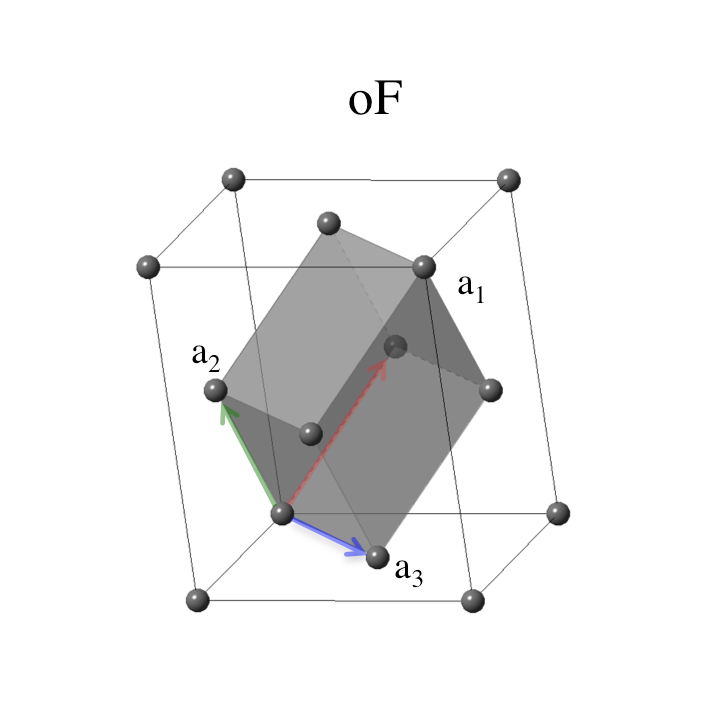
While the base-centered monoclinic lattice allows translations to
one base plane, the face-centered orthorhombic lattice allows
translations to any of the base planes. Our standard choice for the
primitive vectors of this system are given by
\begin{eqnarray}
\mathbf{a}_1 & = & ~ \frac{b}{2} \, \mathbf{\hat{y}} + \frac{c}{2} \, \mathbf{\hat{z}} \\
\mathbf{a}_2 & = & ~ \frac{a}{2} \, \mathbf{\hat{x}} + \frac{c}{2} \, \mathbf{\hat{z}} \\
\mathbf{a}_3 & = & ~ \frac{a}{2} \, \mathbf{\hat{x}} + \frac{b}{2} \, \mathbf{\hat{y}}.
\end{eqnarray}
The volume of the primitive face-centered orthorhombic unit cell is
\begin{equation}
V = \frac{a \, b \, c}{4}~ ,
\end{equation}
so that there are four primitive body-centered orthorhombic unit
cells in the conventional orthorhombic unit cell.
The space groups
associated with this lattice, all of which begin with $\mbox{F}$ in
standard notation, are
\begin{array}{lll}
22. ~ \mbox{F222} & 42. ~ \mbox{Fmm2} & 43. ~ \mbox{Fdd2} \\
69. ~ \mbox{Fmmm} & 70. ~ \mbox{Fddd} & \\
\end{array}